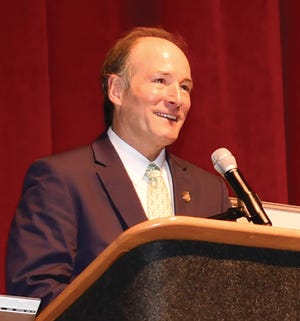March 7, 2022

New York cotton futures are trading at some of their highest levels ever, but those prices may not continue in the $1-per-pound-plus range if U.S. merchants cannot step up the pace of shipments to customers worldwide.
As with other commodities and exports, U.S. cotton shipments have been hampered by congestion at West Coast ports that have led to shipping delays and reports of cargo ships leaving U.S. ports empty.
“We currently have strong demand for U.S. cotton as evidenced by the weekly export sales,” said Ted Schneider, cotton producer from Lake Providence, La., and chairman of the National Cotton Council. “However, weekly shipments have lagged the pace necessary to reach the current USDA export forecast.”
 Ted Schneider, National Cotton Council Chairman. (Brian Ireland)
Ted Schneider, National Cotton Council Chairman. (Brian Ireland)
Schneider, who was elected chairman during the NCC’s annual meeting in Houston earlier this month, spoke at the Mid-South Farm and Gin Show in Memphis, Tenn. The new chairman traditionally gives the opening speech for the cotton marketing session at the Gin Show.
“The Council has been very proactive in working with the Administration and Congress on resolving supply chain dysfunctions that have been seriously undermining U.S. exports,” he said. “We must preserve our industry’s status as a timely mover of quality U.S. cotton to customers worldwide.”
Supply Chain
The current supply chain challenges are adding economic stress to cotton’s merchandising segments that were still feeling the impact of the sharp slowdown in demand when COVID shutdowns were at their peak in 2020.
“We continue to look for opportunities to provide assistance to this critical segment of the industry,” said Schneider, who served as president of Cotton Council International in 2018 and 2019. CCI is the National Cotton Council’s export promotions arm.
Schneider said he wanted to express his sincere appreciation to the USDA Cotton Program for their ongoing efforts to minimize delays and for their willingness to provide weekly updates from each USDA-Agricultural Marketing Service classing office. “The industry is extremely fortunate to have Darryl Earnest and his dedicated staff making every effort to class cotton in a timely manner and mitigate delays.”
In another area concerning the reputation of U.S. cotton, Schneider said the Council is closely monitoring lint contamination being reported by textile customers – most of them involving plastic contamination.
“I know that we emphasize this a lot, but I assure you that lint contamination is negatively affecting the economic health of the entire industry,” he said. “We will be promoting a new standard developed for round module wrap, and we encourage producers and gins to use only those wraps that meet the standard.”
Challenging year
2021 was a challenging year for the cotton industry on many fronts, from weather-related production concerns, unprecedented supply chain and labor issues, legislative challenges, pressure on crop protection product registrations and several regulations under review by the Biden Administration.
“Many of these issues continue to face the industry as we head into 2022, and they will have a direct bearing on our ability to continue competing in the global marketplace,” Schneider noted. “Action on multiple trade issues will be critical to our industry’s overall profitability: Protecting textile trade policy, including yarn forward rule of origin in CAFTA and other regional agreements while seeking policy incentives to help spur greater U.S. investments in the region.”
NCC leaders will also be closely monitoring overall trade relations with China.
“Although China’s overall ag purchases in 2020 and 2021 fell short of the goals established in the Phase I Agreement, China’s purchases of U.S. cotton bounced back to between 3 and 5 million bales, and it is important to preserve that market going forward,” he said.
Climate change and sustainability
Schneider said climate change and sustainability are at the forefront of any discussion related to agriculture. “For U.S. cotton producers, both present a tremendous opportunity as we are well-positioned to make positive contributions in both arenas.
“I believe that we can significantly improve our cotton’s marketability via the U.S. Cotton Trust Protocol. Strong Trust Protocol enrollment continues toward a goal of bringing on board two million bales of cotton from the 2021 harvest. We are actively working to streamline the enrollment process and find opportunities to incentivize a grower’s participation in the program. In fact, we must find opportunities for the Trust Protocol to bring value to all segments of the cotton industry.”
He said the cotton industry initiated the program with the goal of assuring the textile supply chain that U.S. cotton is sustainable. “Widespread participation by producers will serve as a catalyst to drive the continuous improvements necessary to help our industry achieve the 10-year goals for key environmental indicators.
“So now is the time for all U.S. cotton producers to get onboard. The ultimate benefit that will be gained through this program is that manufacturers, major brands and retailers will accept that U.S. cotton is responsibly produced and that we are working continuously to shrink our environmental footprint.”
Regulatory front
On the regulatory front, Schneider said the industry must maintain key crop protection products and technologies, including dicamba, Enlist Duo and glyphosate.
“This will include ongoing offensive and defensive legal actions,” he noted. “The Council will be diligent in seeing that our industry’s ability to operate is not unduly hampered.”
Industry discussions and preparations for the next farm bill will begin later this year in preparation for Congress developing the next farm bill in 2023 when the current Food and Agriculture Act of 2018 is scheduled to expire.
“We anticipate a challenging environment from a budget perspective, and there will be dozens of new members of Congress to education on industry issues and priorities following this year’s mid-term elections,” he said.
“As always, the Council will be dealing with some issues that will require compromise by industry members to achieve a consensus position. I am reminded, though, that the Council has an impressive track record of fostering industry-wide unity. That unity was evident throughout this past year and will remain critical as we work through the issues that we will face this y
About the Author(s)
You May Also Like






